The audio system has been designed to operate easily and to give years of listening pleasure. You will get the most enjoyment out of it if you acquaint yourself with it first. Find out what your audio system can do and how to operate all its features to be sure you're getting the most out of the advanced engineering that went into it.
The ignition must be in a position other than OFF or Retained Accessory Power (RAP) must be active for your audio system to work. See "Retained Accessory Power (RAP)" in Section 2 of your vehicle's owner manual for more information.
The audio system is operated using menus located on the Navigation System screen. The audio menus are explained in this section.
Radio Screen
To access the Radio screen, press the BAND button located to the left of the display or choose Radio from the Main Menu. See Main Menu for more information.
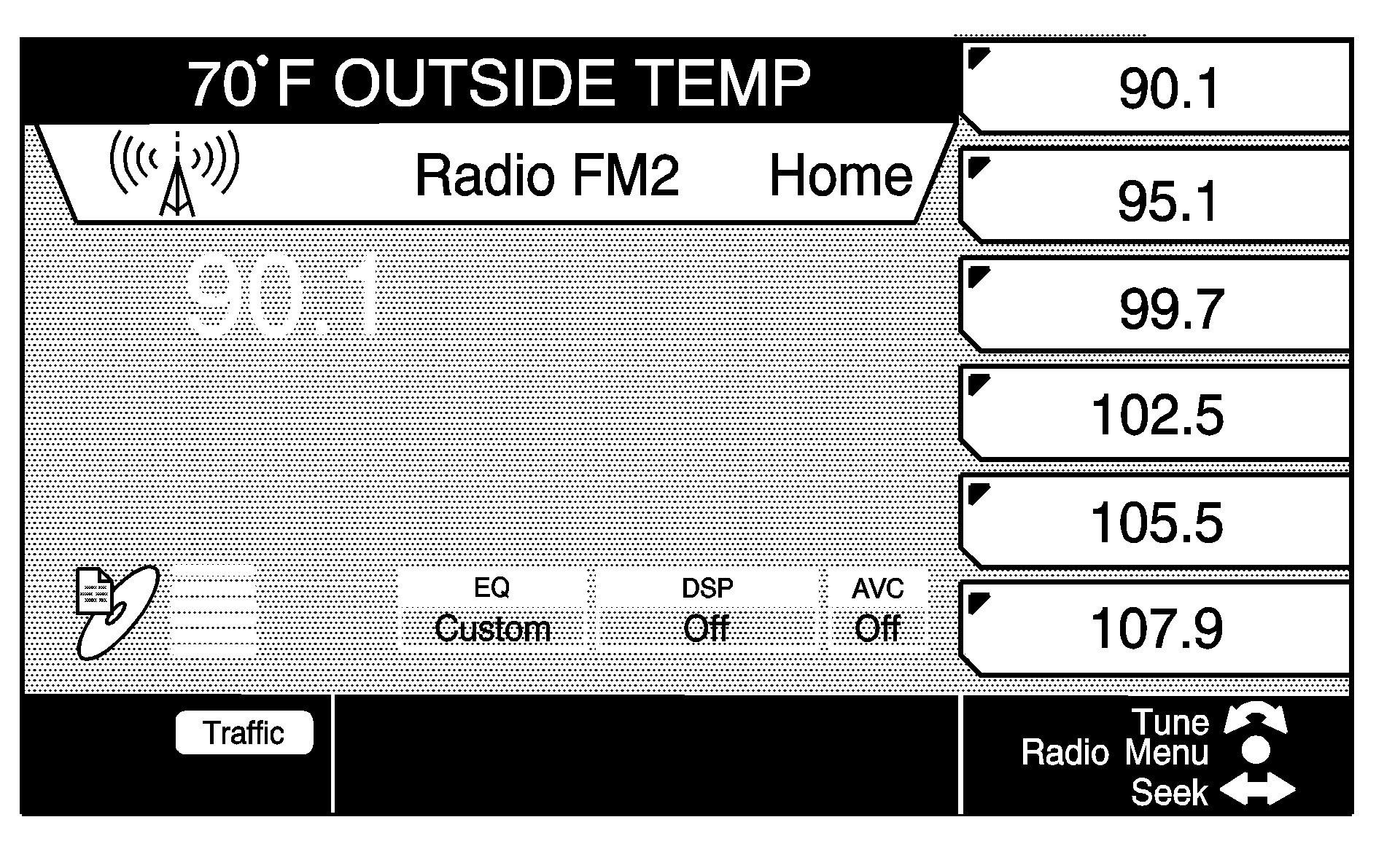
The Radio screen will have preset stations listed vertically at the right side of the screen, and the currently selected station frequency will appear in the center of the screen. At the top of the screen the Driver Information Center (DIC) status line will appear. See "Driver Information Center (DIC)" in the Instrument Panel section of your CTS owner's manual. Directly below the DIC information, you will see the banner with Radio and the currently selected band. For example, Radio FM1 means that the presets for FM1 are displayed at the right of the screen. You will also see either Autostore, Home or Away. This will tell you which set of presets are displayed. See "FM Menu" following in this section and Screen Features for more information.
Near the bottom left of the screen, you will see six horizontal lines. This is for the six-disc CD changer. To the right of the CD changer information is the equalizer, Digital Signal Processing (DSP) and Automatic Volume Compensation (AVC) information. See "Setting the Tone" and "Playing a CD" later in this section for more information.
AM Menu
This menu allows you to customize the AM presets.
To access the AM Menu you must be in the Radio screen with the AM band active. Pressing the TUNE/SEL knob will bring up the AM Menu. The following multi-function buttons are available:
| • | Home P-Sets |
| • | Away P-Sets |
| • | Autostore |
| • | Back |
For a description of each item, see "FM Menu" following.
FM Menu
This menu allows you to customize the FM presets and RDS presets. To access the FM Menu, you must be on the Radio screen and the FM1 or FM2 band must be active. Press the TUNE/SEL knob once. The following menu will appear:
| • | Help Prompt |
| • | RDS List |
| • | Seek RDS List |
| • | Region |
| • | Alt Frequency |
| • | Display RDS Messages |
| • | Intrpt Volume |
| • | Display Freq |
The following multi-function buttons will also be available:
| • | Select |
| • | Home P-Sets |
| • | Away P-Sets |
| • | Autostore |
| • | Back |
RDS (Radio Data Systems) List: This menu item allows you to choose the type of radio station programs you listen to by category rather than frequency. Press the TUNE/SEL knob once to access the following menu:
| • | Adult Hits |
| • | Classic Rock |
| • | Classical |
| • | College |
| • | Country |
| • | Information |
| • | Jazz |
| • | Language |
| • | News |
| • | Nostalgia |
| • | Oldies |
| • | Personality |
| • | Public |
| • | R & B |
| • | Religious Music |
| • | Religious Talk |
| • | Rock |
| • | Soft |
| • | Soft R & B |
| • | Soft Rock |
| • | Sports |
| • | Talk |
| • | Top 40 |
| • | Weather |
| • | Set All (selects all categories) |
| • | Clear All (clears all currently selected categories) |
| • | Seek Selected (seeks to currently selected categories) |
To select a category, scroll to the menu item by turning the TUNE/SEL knob. Once the category you want is highlighted, press the knob once. When the category is selected, an X will appear in the box to the left. To seek to a station using the selected menu items, see "Seek RDS List" following. For more information on RDS, see "Radio Data Systems (RDS)" under "Audio Systems" in the Instrument Panel section of your CTS owner's manual for more information.
Seek RDS List: To seek to the selected categories on the RDS list, press the TUNE/SEL knob once when Seek RDS List is highlighted. The radio will immediately begin seeking to an available radio station that matches the category(ies) selected.Region: This menu item allows you to turn the Region feature on and off. Press the TUNE/SEL knob to switch back and forth between on and off. When this feature is turned on, an X will appear in the box to the left.
Alt (Alternate) Frequency: This menu item allows the radio to automatically switch to a stronger station with the same programming. Press the TUNE/SEL knob to switch back and forth between on and off. When this feature is turned on, an X will appear in the box to the left.
Display RDS Messages: This menu item allows you to see RDS messages broadcast by the currently selected radio station. Press the TUNE/SEL knob to switch back and forth between on and off. When this feature is turned on, an X will appear in the box to the left. For XM™ (USA only, if equipped), this item will read Show Msg (message). Use the TUNE/SEL knob to turn this feature on and off. If the feature is on, messages will be automatically be displayed. If it is off, a Message Available icon will be displayed when a message has been received. When turned on, any RDS messages broadcast will appear in the bottom center of the screen. If no message is available, this area will be blank. RDS messages only appear on the Radio screen. See "Radio Data Systems (RDS)" in Section 3 of your vehicle's owner manual for more information. The RDS message feature is available for the FM bands and for RDS radio stations only. RDS messages will only appear if the Message feature is turned on.
Intrpt (Interrupt) Volume: This menu item allows you to set the volume level of the traffic announcements you receive from the system. To change the current volume level, do the following:
- Press the TUNE/SEL knob once to access the adjustment bar graph.
- Turn the knob to increase or decrease the volume level.
- Once you reach the volume level you want, press the knob once to set your selection.
Select: Press this multi-function button to choose a highlighted menu item from the FM Menu.
Home Presets: This multi-function button allows you to display your home, or local, radio station presets. Press the multi-function button next to Home P-Sets, and the preset stations at the right of the screen will change to your local presets. Home will appear on the screen near the current station frequency. To store preset radio stations, see "Setting Preset Stations" listed later in this section.
Away Presets: This multi-function button allows you to display the preset radio stations for when you are traveling out of town. Press the multi-function button next to Away P-Sets, and the preset stations at the right of the screen will change to the preset stations stored for when you travel. Away will appear on the screen near the current station frequency. To store preset radio stations, see "Setting Preset Stations" listed later in this section.
Autostore: This multi-function button allows you to store the six radio stations with the strongest signals as presets. Press the multi-function button next to Autostore to activate this feature. The preset prompts at the right of the screen will update once Autostore is finished. See "Setting Preset Stations" listed later in this section.
Back: This multi-function button returns you to the main Radio screen.
XM™ Menu
When XM™ is active, the channel name and number, song title, artist, and category will be displayed on the screen.
To access the XM™ Menu you must be in the Radio screen with the XM1 or XM2 band active. Pressing the TUNE/SEL knob will bring up the XM™ Menu.
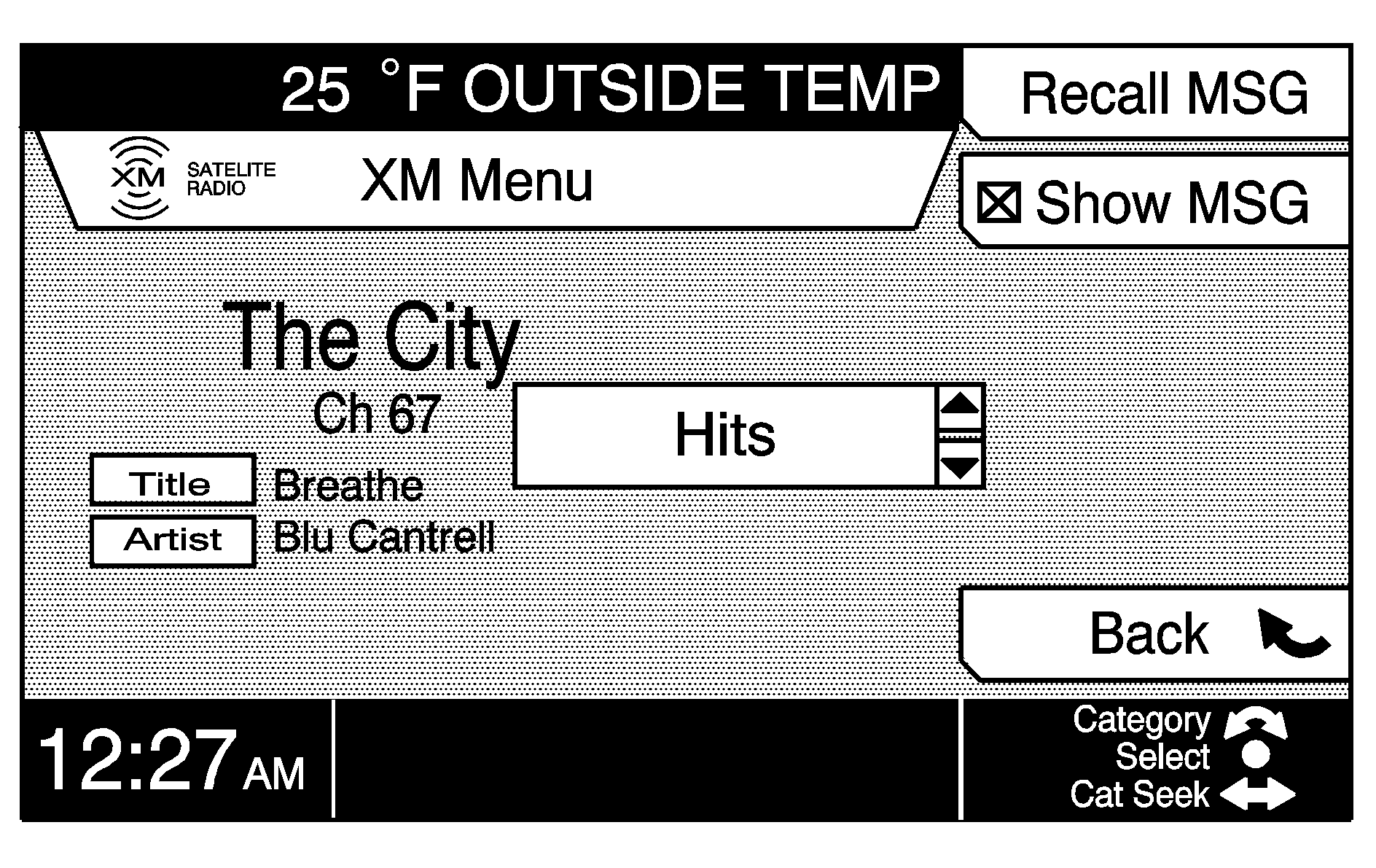
This menu allows you to seek or scan for stations based on their category. While in this menu you can turn the TUNE/SEL knob to scroll through the categories and press it to select the category you want to seek to. Use the SEEK/SCAN switch or press the TUNE/SEL knob to seek to the first available channel in the selected category.
XM™ Radio Satellite Service (USA Only)
XM™ is a continental U.S. based satellite radio service that offers 100 coast to coast channels including music, news, sports, talk and children's programming. XM™ provides digital quality audio and text information, including song title and artist name. A service fee is required in order to receive the XM™ service. For more information, contact XM™ at www.xmradio.com or call 1-800-852-XMXM (9696).
Playing the Radio
The BAND button is located on the left side of the Navigation System screen. Press this button once to access the audio system. You can also access the audio system from the Navigation Main Menu. See Main Menu . Use the following controls to operate the audio system:
PWR/VOL (Power/Volume): Press this knob located to the lower left of the display to turn the Navigation System on and off. Turn the knob to increase or decrease the volume level. You can also adjust the volume level using the steering wheel controls. See "Audio Steering Wheel Controls" in the Instrument Panel section of your CTS owner's manual for more information.Finding a Station
BAND: After you access the main radio display, press this button repeatedly to scroll through the bands: AM, FM1, FM2, XM1 and XM2 (USA only, if equipped). The one currently selected is shown near the top of the display. For example, Radio FM2 will be displayed when the FM2 screen is selected.TUNE/SEL (Select): Use this knob located to the lower right of the display to manually tune the radio, access the radio menus and scroll through the menu items. See "FM Menu" listed previously in this section for more information.
SEEK/SCAN : Press the left or right arrow to seek to the previous or next station. The radio will go to the next station with a strong signal only. If you wish to continue seeking, press the arrow again. The volume will mute while seeking. To scan stations, press and hold the left or right arrow for two seconds until you hear a beep. The radio will go to the next or previous station, play for a few seconds, then go on to the next station. The radio will scan to stations with a strong signal only. The volume will mute while scanning. Press either arrow again to stop scanning. To scan preset radio stations, press and hold the left or right arrow for more than four seconds. You will hear two beeps and Preset Scan will appear on the screen. The radio will go to the first preset station stored, play for a few seconds, then go on to the next preset station. The radio will scan preset stations with a strong signal only. The volume will mute while scanning. Press the left or right arrow again to stop scanning presets. See "Setting Preset Stations" later in this section for more information.
Setting the Tone
Press the AUDIO button located to the left of the screen to access the Audio screen.
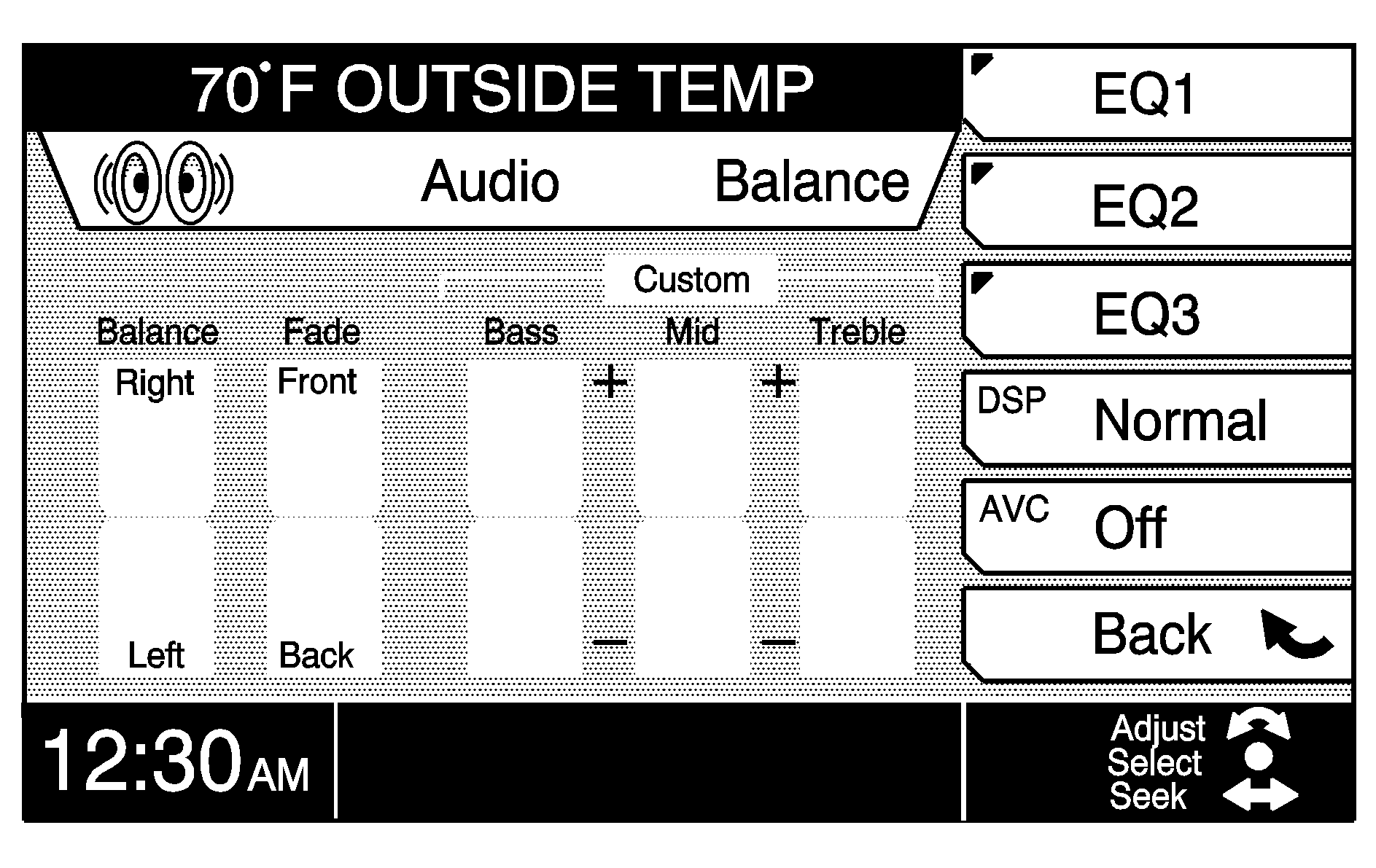
To manually adjust the tone, use the TUNE/SEL knob. The system will begin with Balance. Turn the knob to adjust the level. Once you find the level you want, press the knob once to set it. The system will advance to the right to Fade.
If you do not wish to change the current setting, press the knob repeatedly to advance to the feature you wish to adjust.
Balance: Turn the TUNE/SEL knob to adjust Balance toward Right or Left.Fade: Turn the TUNE/SEL knob to adjust Fade toward Front or Back.
Bass: Turn the TUNE/SEL knob to increase or decrease Bass.
Mid (Midrange): Turn the TUNE/SEL knob to increase or decrease Midrange.
Treble: Turn the TUNE/SEL knob to increase or decrease Treble.
EQ 1-3 (Equalizer): Once you adjust the bass, midrange and treble, you can save them for future use. You may store up to three customized equalizations. To store equalizations, do the following:
- Manually set the levels for Bass, Mid and Treble.
- Press and hold one of the three equalization buttons.
You will hear a beep once the equalization is stored successfully.
Equalization settings are unique to each source, and they must be set individually for each source. For example, if you select EQ1 for the CD changer and then switch to a preset radio station, the equalization may not be the same.
You can save an equalization setting for each stored preset radio station. See "Setting Preset Stations" listed later in this section for more information.
DSP (Digital Signal Processing): This feature is only available on the Bose® system. This feature is used to provide a choice of five different listening experiences. DSP can be used while listening to the radio or the CD players. A description of the five DSP choices follows:| • | Normal: This setting provides the best overall audio performance for all passengers. |
| • | Talk: This setting is used when listening to non-musical material such as news, talk shows and sports broadcasts. Talk makes spoken words sound very clear. |
| • | Driver Seat: This setting adjusts the audio to give the driver the best possible sound qualities. Driver Seat can be used at any time for any material. |
| • | Rear Seat: This setting adjusts the audio to give the rear seat passengers the best possible sound qualities. Rear Seat can be used at any time for any material. |
| • | Spacious: This setting is used to make the listening area seem larger. |
To change the current DSP settings, do the following:
- Press DSP multi-function button to turn DSP on and to access the DSP choices.
- Continue to press the DSP multi-function button until the desired DSP mode is selected.
- Press the Back multi-function button to exit the DSP menu.
Your choice will be displayed on the DSP prompt at the right of the screen.
The DSP settings are unique to each source, and they must be set individually for each source. For example, you may have Talk selected for a preset radio station, but if you change to the CD changer, Spacious may be selected.
You can also store separate DSP settings for each preset station. See "Setting Preset Stations" following and "Playing a CD" later in this section for more information.
AVC (Automatic Volume Compensation): This feature is only available on the Bose® system. This feature monitors the noise in the vehicle. Then, AVC automatically adjusts the volume level so that it always sounds the same to you. AVC works best when listening at low volume levels. At louder listening levels there will be little or no effect. To turn AVC on and off, press the AVC multi-function button.Setting Preset Stations
The six multi-function buttons next to the display allow you to store your favorite radio stations. You can set up to 30 different preset stations, six per band, AM, FM1, FM2, XM1, and XM2 (USA only, if equipped). The Home and Away presets each have 30 separate presets. For more information on the Home and Away feature, see "FM Menu" listed previously in this section.
To store a radio station as a preset, use the following steps:
- Select the band where you want the preset stored by pressing the BAND button.
- Select either the Home or Away presets. See "FM Menu" listed previously in the section for more information on the Home and Away feature.
- Tune to the desired station using the TUNE/SEL knob or the SEEK/SCAN switch.
- Choose the equalization and DSP settings you want.
- Press and hold the multi-function button next to the preset you want.
- Repeat the steps to store other presets.
See "Setting the Tone" listed previously for more information.
You will hear a beep when the preset has been stored, and the frequency of the stored station will appear on the preset prompt at the right of the display.
To select a stored preset station listed on the screen, press the multi-function button next to the station prompt. The station will change, and the new radio station frequency will be displayed in the center of the screen.
Radio Display Message | Condition | Action Required |
|---|---|---|
XL (Explicit Language Channels) | XL on the radio display, after the channel name, indicates content with explicit language. | These channels, or any others, can be blocked at a customer's request, by calling 1-800-852-XMXM (9696). |
XM Updating | Updating encryption code | The encryption code in your receiver is being updated, and no action is required. This process should take no longer than 30 seconds. |
No XM signal | Loss of signal | Your system is functioning correctly, but you are in a location that is blocking the XM signal. When you move into an open area, the signal should return. |
Loading XM | Acquiring channel audio (after 4 second delay) | Your radio system is acquiring and processing audio and text data. No action is needed. This message should disappear shortly. |
Channel Off Air | Channel not in service | This channel is not currently in service. Tune in to another channel. |
Channel Unavail | Channel no longer available | This previously assigned channel is no longer assigned. Tune to another station. If this station was one of your presets, you may need to choose another station for that preset button. |
No Artist Info | Artist Name/Feature not available | No artist information is available at this time on this channel. Your system is working properly. |
No Title Info | Song/Program Title not available | No song title information is available at this time on this channel. Your system is working properly. |
No CAT Info | Category Name not available | No category information is available at this time on this channel. Your system is working properly. |
Not Found | No channel available for the chosen category | There are no channels available for the category you selected. Your system is working properly. |
No Information | No Text/Informational message available | No text or informational messages are available at this time on this channel. Your system is working properly. |
XM Theftlocked | Theft lock active | The XM receiver in your vehicle may have previously been in another vehicle. For security purposes, XM receivers cannot be swapped between vehicles. If you receive this message after having your vehicle serviced, check with the servicing facility. |
XM Radio ID | Radio ID label (channel 0) | If you tune to channel 0, you will see this message alternating with your XM Radio 8 digit radio ID label. This label is needed to activate your service. |
Unknown | Radio ID not known (should only be if hardware failure) | If you receive this message when you tune to channel 0, you may have a receiver fault. Consult with your dealer. |
Check XM Receiver | Hardware failure | If this message does not clear within a short period of time, your receiver may have a fault. Consult with your retail location. |
Playing a CD
CD changer screen shown, single CD player similar
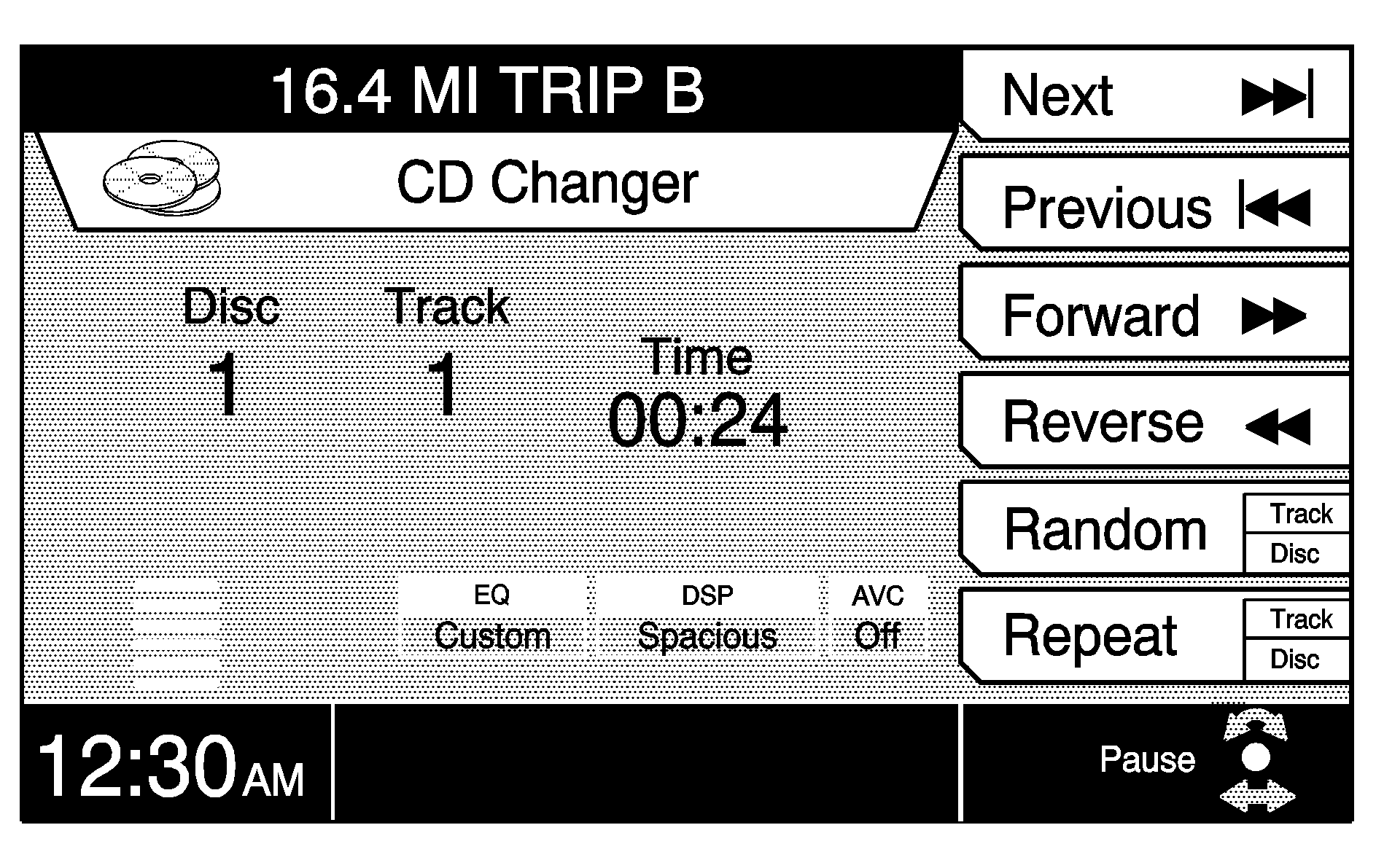
You can play a single CD by sliding the CD into the slot located above the audio system screen or by using the six-disc CD changer located below the screen.
The following controls are used for both CD players unless otherwise noted:
DISC: Press this button located to the left of the screen to access the CD changer screen. The CD changer will begin playing the currently loaded CD, and you will see the disc and disc number, track and the track number as well as TIME and the amount of time the track has been playing displayed on the screen. The single CD player screen will be displayed if a music CD is loaded in the player and no CDs are loaded in the CD changer. If you have a CD text disc and are using the single CD player, any information stored on the CD will appear on the screen. Possible text includes the title of the song, the artist and the title of the CD. Text will not appear on the screen if you are using the CD changer.LOAD (Six-Disc CD Changer Only): Press this button before loading a CD into the CD changer. One beep will sound, and you will be prompted to load the CD. To load all six CDs at one time, press and hold the LOAD button until two beeps sound. You will then be prompted to load six discs into the CD changer.
Repeat: Press the multi-function button next to the Repeat prompt to turn this feature on. For the CD changer, the first press of the Repeat multi-function button will turn on Repeat Disc. The CD changer will play the currently selected disc again once the last track has ended. When Repeat Disc is turned on, it will be highlighted on the Repeat prompt at the right of the screen. Press the Repeat multi-function button again to switch to Repeat Track. This feature allows the CD changer to play the currently selected track again once the track has ended. When Repeat Track is turned on, it will be highlighted on the Repeat prompt at the right of the screen. Press the button a third time while using the CD changer to turn off the Repeat feature. For the CD player, the first press of the Repeat button will turn Repeat Track on. The second press will turn Repeat Track off.
Random: Press the multi-function button next to the Random prompt to turn this feature on. For the CD changer, the first press of the Random multi-function button will turn on Random Disc. Random Disc allows the CD player to play the discs loaded in the CD changer in random, rather than sequential, order. When Random Disc is turned on, it will be highlighted on the Random prompt at the right of the screen. Press the Random multi-function button again to switch to Random Track. This feature allows the CD changer to play the tracks on the current disc in random, rather than sequential, order. When Random Track is turned on, it will be highlighted on the Random prompt at the right of the screen. Press the button a third time while using the CD changer to turn off the Random feature. For the CD player, the first press of the Random button will turn Random Track on. The second press will turn Random Track off.
Pause: To pause the playback of a CD, press the TUNE/SEL knob once. Press it again to resume playback.
Forward : Press and hold the multi-function button next to Forward to quickly advance within the current track. As the CD advances, the elapsed time will be displayed to help you find the correct passage.
Reverse : Press and hold the multi-function button next to Reverse to quickly go backward within the current track. As the CD reverses, the elapsed time will be displayed to help you find the correct passage.
Next : Press the multi-function button next to the Next prompt to advance to the next track on the current CD. You can also use the steering wheel controls to change tracks. See "Audio Steering Wheel Controls" in the Instrument Panel section of your CTS owner's manual. If you press and hold this button for two or three seconds while in single CD mode, the system will scan the tracks. If more than one CD is loaded in the CD changer, pressing the Next multi-function button will advance the CD changer to the next loaded CD. If it is the last track on the current CD, the next CD will begin playing at track one.
Previous : Press the multi-function button next to the Previous prompt to skip to the track immediately before the current track on the current CD, if less than eight second have played. If the current track has been playing for more than eight seconds, pressing the Previous button will take you to the beginning of the current track. You can also use the steering wheel controls to change tracks. See "Audio Steering Wheel Controls" in the Instrument Panel section of your CTS owner's manual. If more than one CD is loaded in the CD changer and you press the Previous multi-function button when less than eight seconds have played, the CD changer will skip to the CD loaded immediately before the current CD. If it has been less than eight seconds, the changer will skip to the beginning of the current CD. The new CD will begin playing at track one.
SEEK/SCAN (Six-Disc CD Changer Only) : Use the left or right arrow to skip to the previous or next CD loaded in the CD changer. The new CD will begin playing at track one.
(Eject): Press the button with this symbol on it to eject a CD. There is a separate eject button for each player next to the CD slot. You will hear a beep once the CD is removed from the slot. If you press the eject button next to the CD changer, the current disc will be ejected and the next one will begin playing. Press and hold the eject button to eject all of the discs loaded in the changer. You will hear a double beep.
BAND: Press this button located to the left of the screen once to switch to the radio while playing a CD. The audio system screen will appear. See "Radio Screen" listed previously for more information.
Loading the CD Changer
You can load up to six CDs in the CD changer. To load discs, use the following steps:
- Press the LOAD button. You will hear one beep and will be prompted to load the CD. The system will switch to CD and begin playing the disc.
- Slide discs one at a time, label side up, into the slot located below the screen.
If you press and hold the LOAD button until two beeps sound, you will be prompted to load all six discs.
After each one is loaded, you will hear a beep. As the CDs are loaded, the horizontal lines located in the lower left of the screen will change colors. If a line is gray, it means that no CD is loaded in that slot. If a line is green, it means that a CD is loaded in the slot. The slot with the currently active CD is yellow.
XM™ Satellite Radio Antenna
Your XM™ Satellite Radio antenna is located on the roof of your vehicle. Keep this antenna clear of snow and ice build up for clear radio reception.
| Table 1: | RDS Program Type (PTY) Selections |
The audio system has been designed to operate easily and give years of listening pleasure. You will get the most enjoyment out of it if you acquaint yourself with it first. Find out what your audio system can do and how to operate all its features, to be sure you are getting the most out of the advanced engineering that went into it.
The ignition must be in a position other than OFF or retained accessory power must be active for your audio system to work. See "Retained Accessory Power (RAP)" in the Features and Controls section of your owner manual for more information.
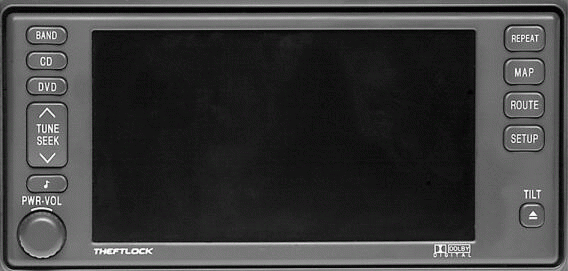
The audio system is controlled by using the menus in the navigation system screen. These audio menus are explained in this section.
Playing the Radio
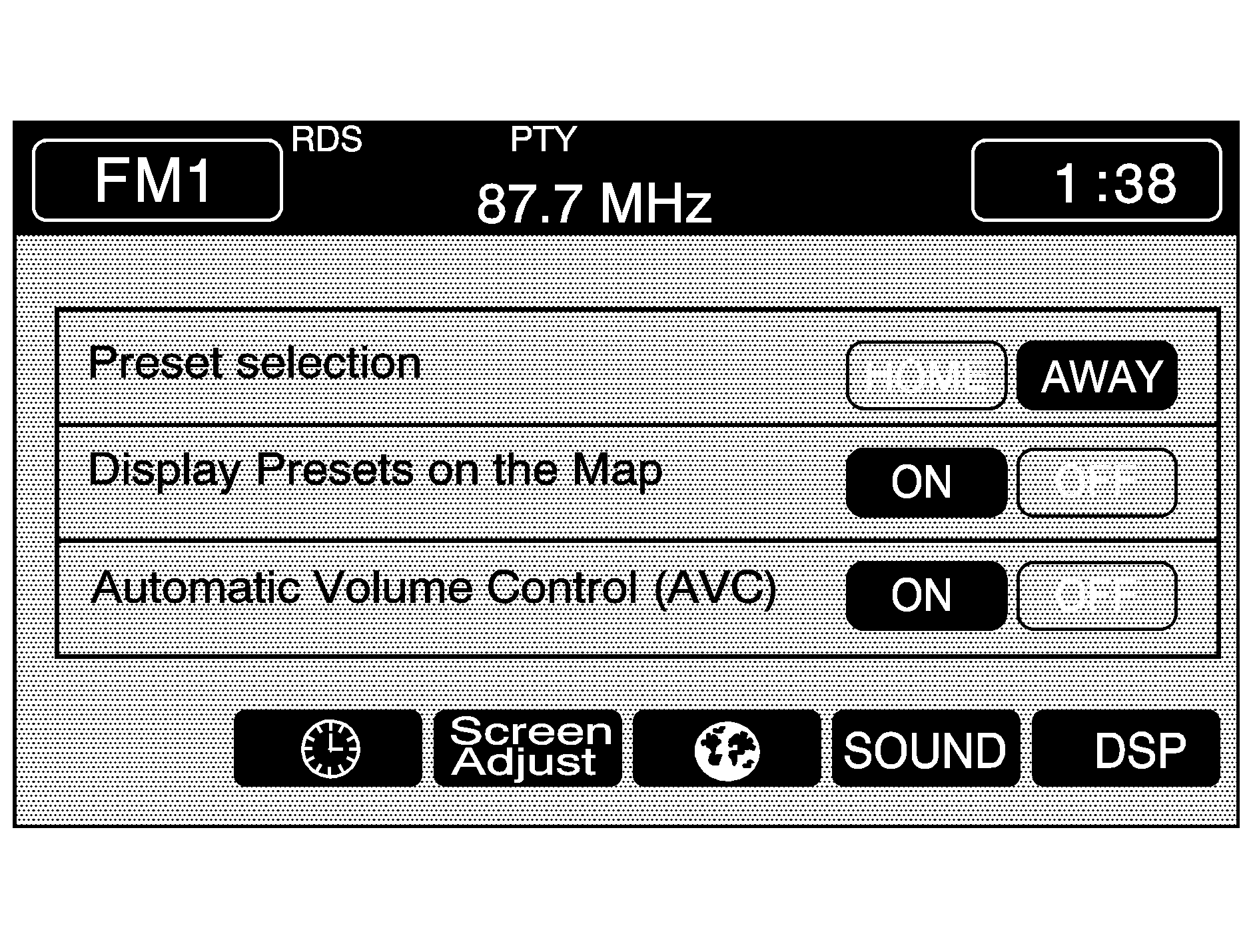
(Audio): Press this hard key to view the main audio screen.
PWR (Power): Press this knob lightly to turn the system on or off.
VOL (Volume): Turn this knob clockwise or counterclockwise to increase or decrease the volume.
TUNE SEEK : Press and release the up or down arrow repeatedly to manually tune to a radio station. To seek to the next higher or lower station, press and hold the up or down arrow on the switch for a few seconds. To fast tune, press and hold the up or down arrow. While using the CD player, optional CD changer or the DVD player, this switch can be used to advance or reverse tracks and chapters. See Six-Disc CD Changer and CD/DVD Player for more information.
BAND: This hard key changes the selected audio source (AM, FM 1/2, XM 1/2 if equipped, or WX). If you are in a map mode and press this hard key, the audio source preset menu will not change but the audio source will.
Preset Selection: Here you can program the audio system's presets to recall your home settings by touching the HOME button. You can also recall the presets you use when traveling to another area by touching the AWAY button. For more information on how to store preset stations, see "Preset Station Menu" later in this section. The Home and Away feature is not available for the XM™ Satellite Radio Service bands (if equipped).
Display Presets on the Map: When this feature is on, your audio system's presets for the current audio source will be displayed on the left of the map screen. Touch the ON button to turn this feature on. Touch the OFF button to turn this feature off.
Automatic Volume Control (AVC): If your vehicle has the Bose system, you will have this feature. With AVC, your audio system monitors the noise in the vehicle. Then, AVC automatically adjusts the volume level so that it always sounds the same to you. To use AVC, touch the ON button. To turn it off, touch the OFF button.
Clock
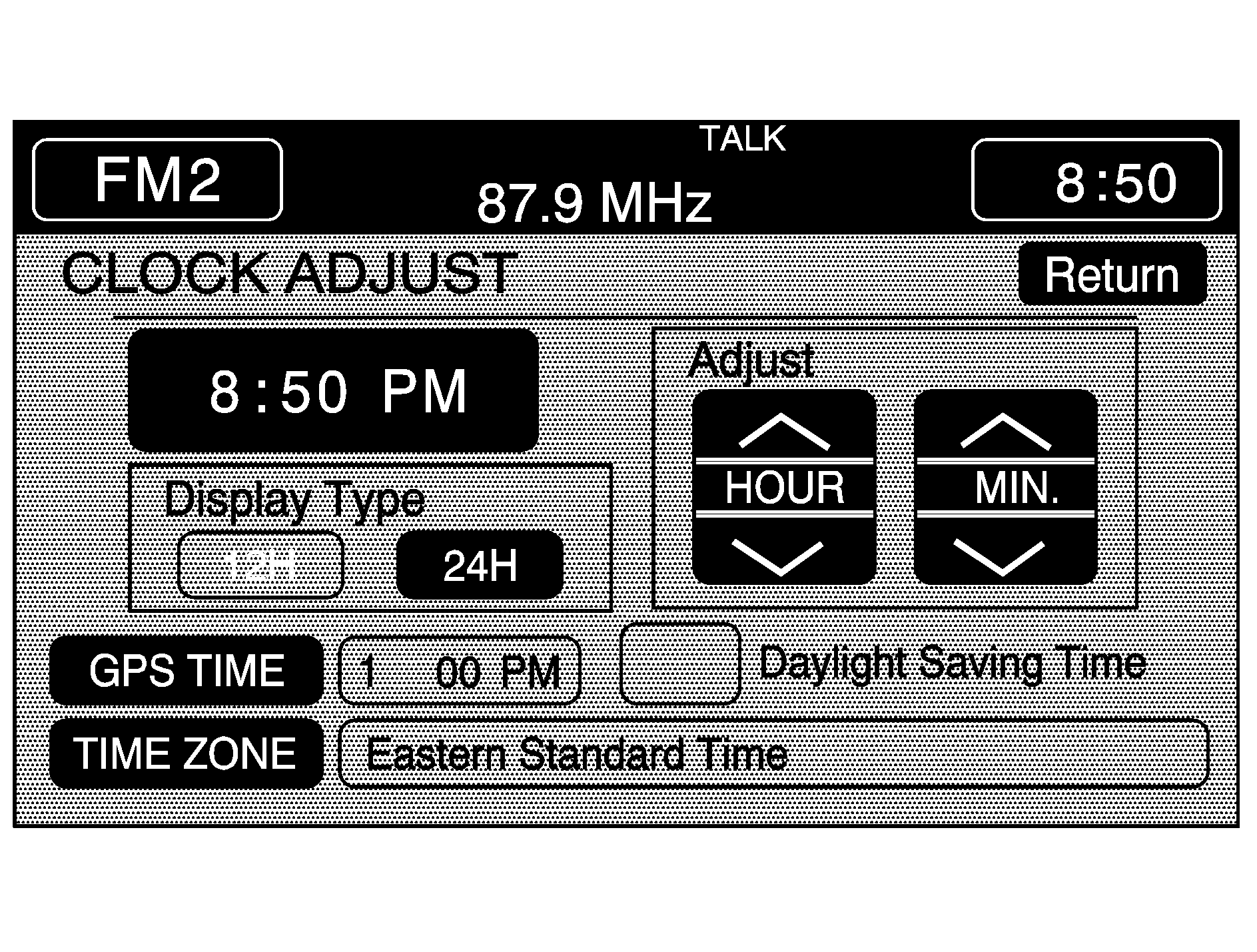
Touch the button with the clock symbol or touch and hold the time display button in the upper right corner from any menu to see the menu for setting the clock. Touching the time display button will also display the date.
HOUR: Touch the up arrow to increase the hour or the down arrow to decrease the hour. If you touch and hold one of the arrows, the numbers will advance quickly.MIN.: Touch the up arrow to increase the minutes or the down arrow to decrease the minutes. If you touch and hold one of the arrows, the numbers will advance quickly.
12H: Touch 12H to set the clock in a.m. and p.m. time.
24H: Touch 24H to set the clock in military time.
GPS TIME: The current GPS (Global Positioning System) time will be displayed to the right of this button. Touch GPS TIME to set the navigation system's time to match the current GPS time. If the seconds for the present minute are greater than thirty when GPS TIME is selected the clock will automatically round up to the next minute.
Daylight Saving Time: Touch this button to increase the time setting by one hour. Then touch GPS TIME to save the new setting. If the button is light blue, the daylight savings time function is on. If the button is dark blue, the daylight savings time function is off.
TIME ZONE: The selected time zone will appear to the right of this touch sensitive button. Touch this button to change the time zone. The time of the selected zone is displayed to the right of the GPS TIME button. To set the system clock to the new settings touch GPS TIME.
If the system is not receiving GPS information, you can still set the time manually as described above but the GPS time and the daylight saving time functions will not be available.
Touch the RETURN button to go back to the previous menu. Your time is now set.
Screen Adjust
To adjust the brightness or contrast of the screen, touch the SCREEN ADJUST button to display the following menu.
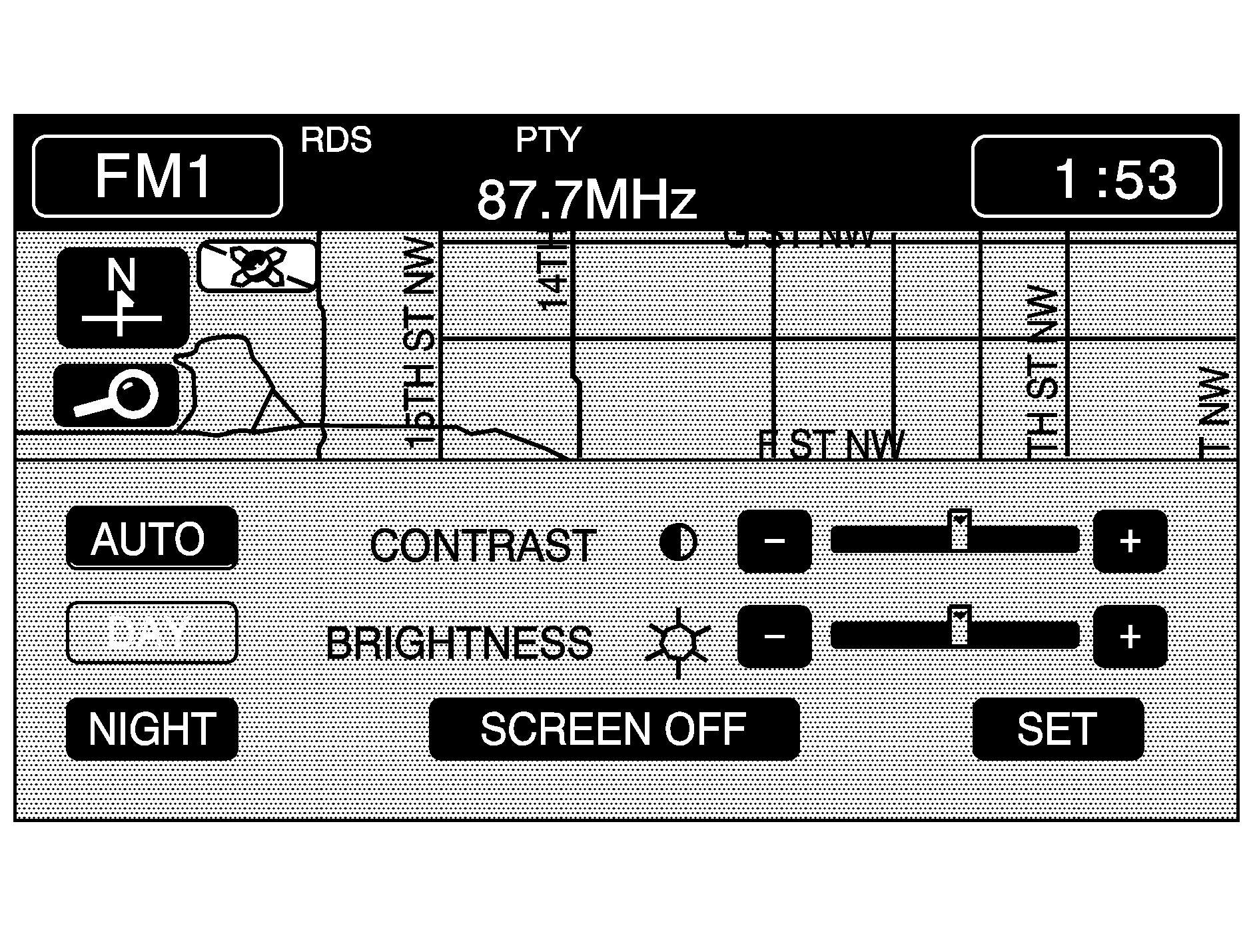
(Contrast): Touch the plus (+) or minus (-) to adjust the contrast of the screen. You will see the screen change. Touch the SET button to confirm the setting and take you back to the previous screen.
[sung ](Brightness): Touch the plus (+) or minus (-) to adjust the brightness of the screen. You will see the screen change. Touch the SET button to confirm the setting and take you back to the previous screen.
AUTO: This setting automatically adjusts the contrast and brightness of the screen. It does this by using the sensors in conjunction with your vehicle's lighting system. See "Exterior Lamps" in the Instrument Panel section of your owner manual for more information.
DAY: This setting leaves the screen in day mode. Day mode is the mode best suited for daylight conditions. The displays on the screen are usually brighter with a lighter background so that you can see them better during the brighter daylight hours.
NIGHT: This setting leaves the screen in night mode. Night mode is the mode best suited for nighttime conditions. The displays on the screen are usually dimmer with a darker background so that you can see them better during the darker nighttime hours.
SCREEN OFF: Press the SCREEN OFF button to turn off the screen. Press any hard key to turn the screen back on. The appropriate menu screen for that hard key will appear.
SET: Press SET to save your choices and exit the clock menu.
Language
Your vehicle has been set for the English language. If you wish to change the language to French, Italian, Spanish or Dutch, do the following:
- Touch the button with the globe symbol on it.
- Select the language you prefer. Scroll up or down if needed.
- Touch the RETURN button to take you back to the previous screen.
If the language is changed from English to a different language, the majority of the voice guidance prompts and the screen text will change to the selected language. Remember that the menu screens will not match word-for-word as they appear in this supplement.
If you accidentally select a language and do not understand the menus, turn your engine off and open and close your door. Your Navigation System will turn off. Start the vehicle again and then touch the language symbol button to select the correct language from the start-up screen.
Sound
SOUND: Press this button to access the Sound menu. See "Sound Menu (Tone, DSP, Fade and Balance)" later in this section for more information.DSP
DSP (Digital Signal Processing): Press this button to access the DSP menu. See "Adjusting the Speakers" later in this section for more information.Finding a Station
Non-XM™ Satellite Radio Service screen shown, other sources similar
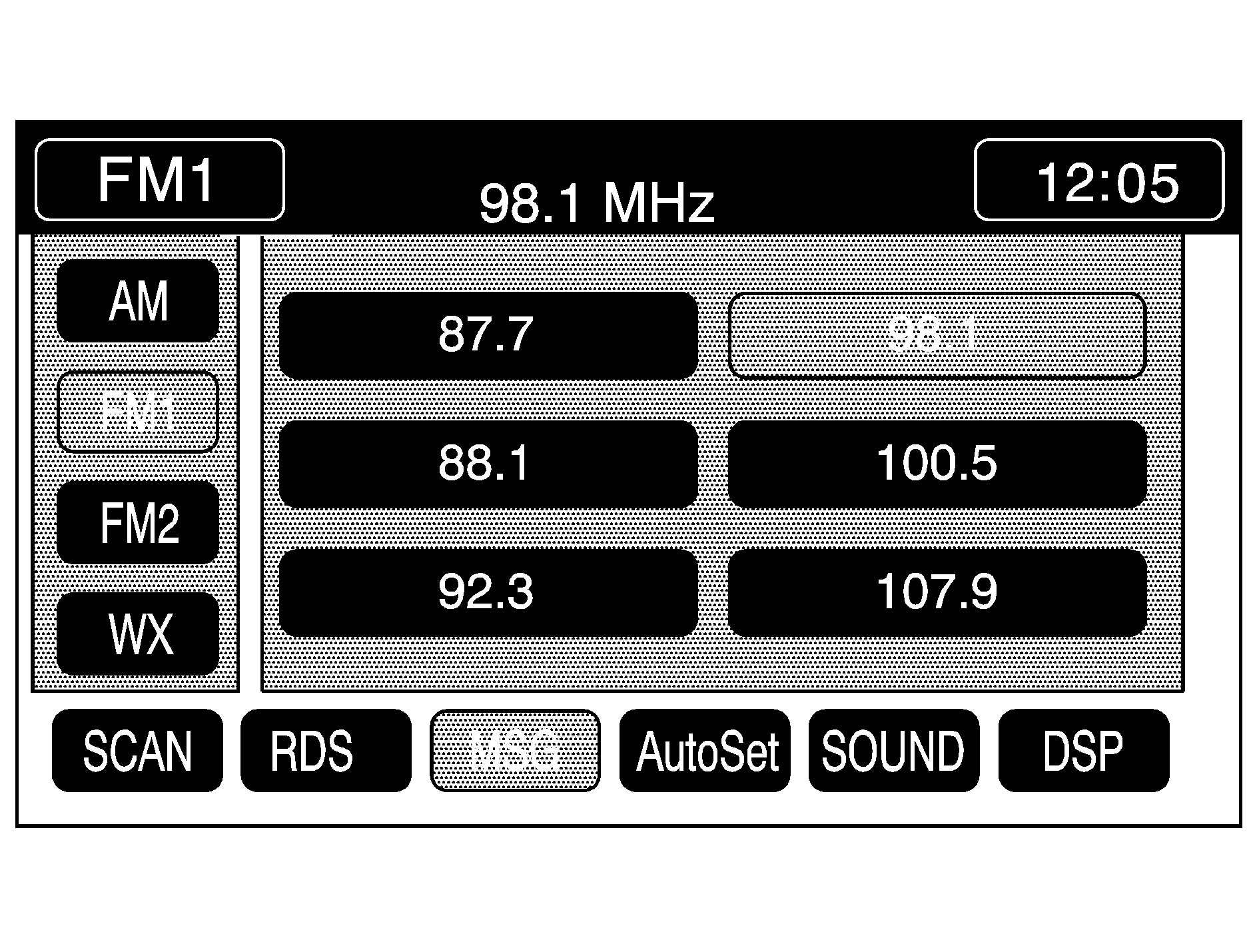
Press the BAND hard key to switch to the desired audio source (AM, FM 1/2, XM 1/2 if equipped and WX). Touch the AM, FM, XM (if equipped) or WX button to switch to the desired source menu.
The source menu screen allows you to do the following:
| • | change sources (AM, FM 1/2, XM 1/2 if equipped and WX), |
| • | set your preset stations, |
| • | scan, |
| • | turn AutoSET on and off, |
| • | turn Radio Data Systems (RDS) on and off while in the FM mode, |
| • | set the sound levels (mid-range, treble, bass, balance and fade) and |
| • | set the Digital Signal Processing (DSP) settings (if equipped). |
TUNE SEEK : Press the up or down arrow to seek to the next or previous station when listening to the radio. While using the CD player, optional CD changer or the DVD player, press the up or down arrow to advance or reverse tracks and chapters. See Six-Disc CD Changer and CD/DVD Player for more information.
Preset Station Menu
There are six buttons to allow you to store your favorite stations. You can store up to 36 stations with XM™ Satellite Radio Service (if equipped) or 24 stations without it (6 AM, 6 FM 1, 6 FM 2, 6 XM 1, 6 XM 2 and 6 WX) for home and for away. Use the following steps to store your presets:
- Turn the audio system on.
- Access your preset stations by touching AM, FM, XM (if equipped) or WX source button to display the desired source screen.
- Your preset station menu will appear.
- Tune in the desired station by using the TUNE/SEEK hard key.
- Touch the SOUND button to set the bass, mid-range, treble and DSP for your preset, if desired. See "Sound Menu (Tone, DSP, Fade and Balance)" later in this secton for more information.
- Touch and hold one of the six numbered preset buttons for more than two seconds or until you hear a beep.
- Repeat the steps for each preset and source.
When battery power is removed and later applied, you will not have to reset your radio preset stations because the audio system remembers them.
SCAN: Touch this button to scan through the stations on the audio system. The audio system will go to a station, stop for five seconds, then go to the next station. Touch the SCAN button again to stop scanning. If a station has weak reception, the audio system will not stop at the station. If you touch and hold SCAN for two seconds, you can scan through your preset stations. It will only scan AM (alone), both FM 1/2, XM 1 (alone), XM 2 (alone) and WX (alone). When the audio system stops on a preset radio station, the preset will be light blue on the screen. You can also touch a preset or the SCAN button again to stop scanning.RDS (Radio Data Systems): See "Radio Data System (RDS)" later in this section for more information on this button.
MSG (Message): See "Radio Data System (RDS)" later in this section for more information on this button.
AutoSet: This button will replace your currently stored preset stations with the strongest stations available in the immediate area when selected. Touch this button again and the system will return to the original preset radio stations.
SOUND: See "Sound Menu (Tone, DSP, Fade and Balance)" following for more information on this button.
DSP: See "Adjusting the Speakers" later in this section for more information on this button.
Sound Menu (Tone, DSP, Fade and Balance)
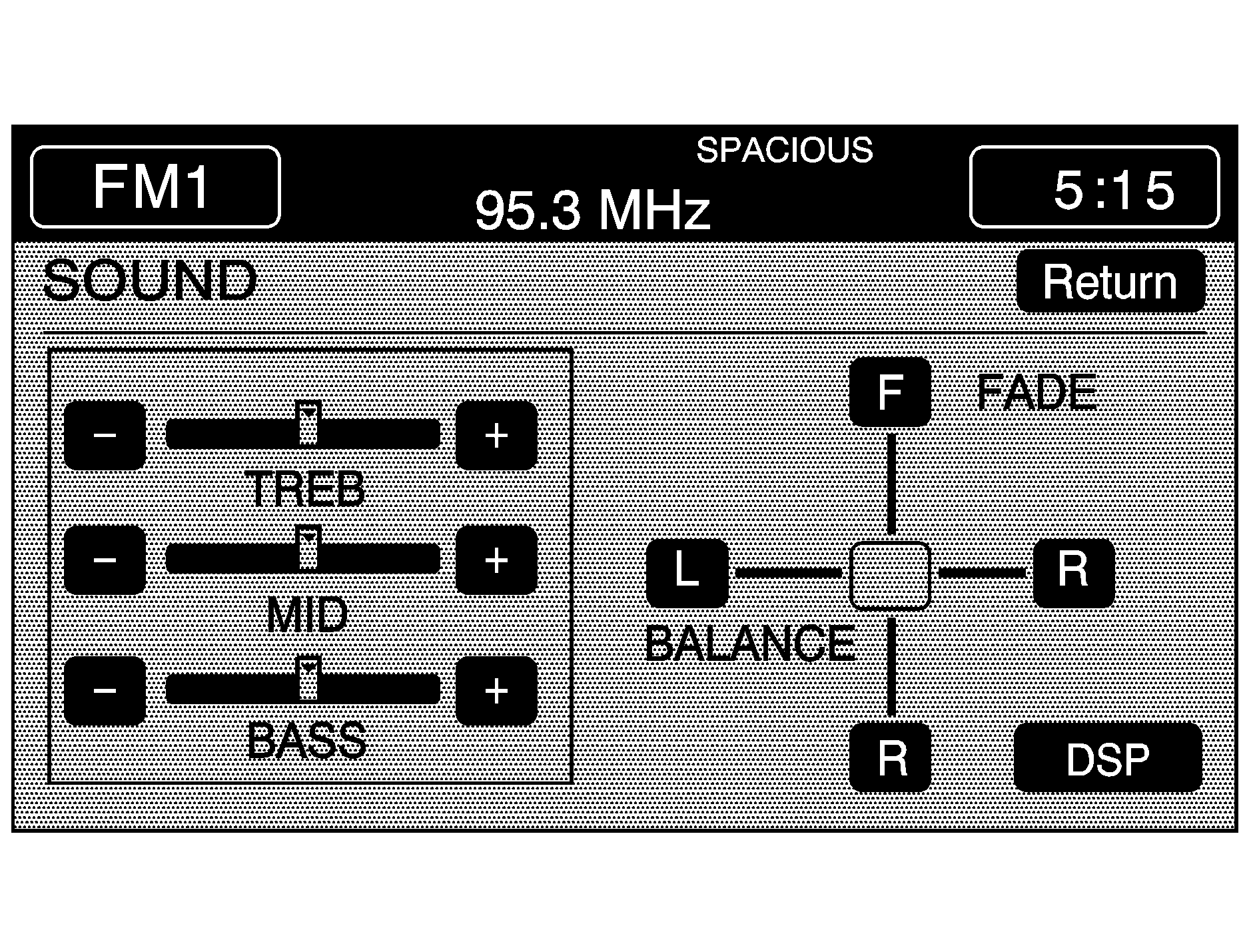
Use the SOUND button to change the TONE, DSP (if equipped), FADE and BALANCE for all of the sources.
To access a screen where the SOUND button is available:
- Press the Audio hard key to access the ADJUST screen. See "Playing the Radio" listed previously for more information.
- Touch the SOUND button.
- Touch the plus (+) or minus (-) buttons to adjust your treble, bass, mid-range, balance and fade to the desired level.
- Touch the DSP button to adjust your DSP (if equipped). See "Adjusting the Speakers" later in this section.
After adjustments are made, touch the AM, FM 1/2, XM 1/2 (if equipped) or WX source button. This will take you back to the preset station menu. Whenever you touch that button, the previously stored information you have entered for each preset station will be recalled.
Adjusting the Tone
You can adjust the tone using the SOUND menu. The audio system has a separate setting for these features for each source preset. The audio system keeps one fade and balance setting for all audio sources (AM, FM 1/2, XM 1/2 if equipped, WX, CD and DVD). The following features can be adjusted for each preset and source:
TREB (Treble): Touch the TREB plus (+) or minus (-) buttons to select the desired level.MID (Mid-Range): Touch the MID plus (+) or minus (-) buttons to select the desired level.
BASS: Touch the BASS plus (+) or minus (-) buttons to select the desired level.
FADE: Touch the F button for more speaker sound in the front of the vehicle and the R button for more speaker sound in the rear of the vehicle. The middle position balances the sound between the front and rear speakers.
BALANCE: Touch the L button for more speaker sound on the left of the vehicle and the R button for more speaker sound on the right of the vehicle. The middle position balances the sound between the left and right speakers.
To adjust the tone for each preset, use the following steps:
- Press the BAND hard key until the desired source appears on the display. See "Preset Station Menu" listed previously for more information.
- Touch the AM, FM 1/2, XM 1/2 or WX source button to access the preferred preset screen.
- Touch the SOUND button.
- Touch the TREB, MID, BASS and DSP buttons to select your preferred settings.
- Once you have completed the adjustments, touch the RETURN button to exit to the preset station menu.
- Touch and hold one of the six preset buttons for more than two seconds or until you hear a beep.
- Repeat the procedure for additional presets if necessary.
Whenever you touch that preset button for less than two seconds, the station and the previously stored information you have entered for each preset station will be set recalled.
Return: Touch this button to exit the SOUND menu and set your choices.
Adjusting the Speakers
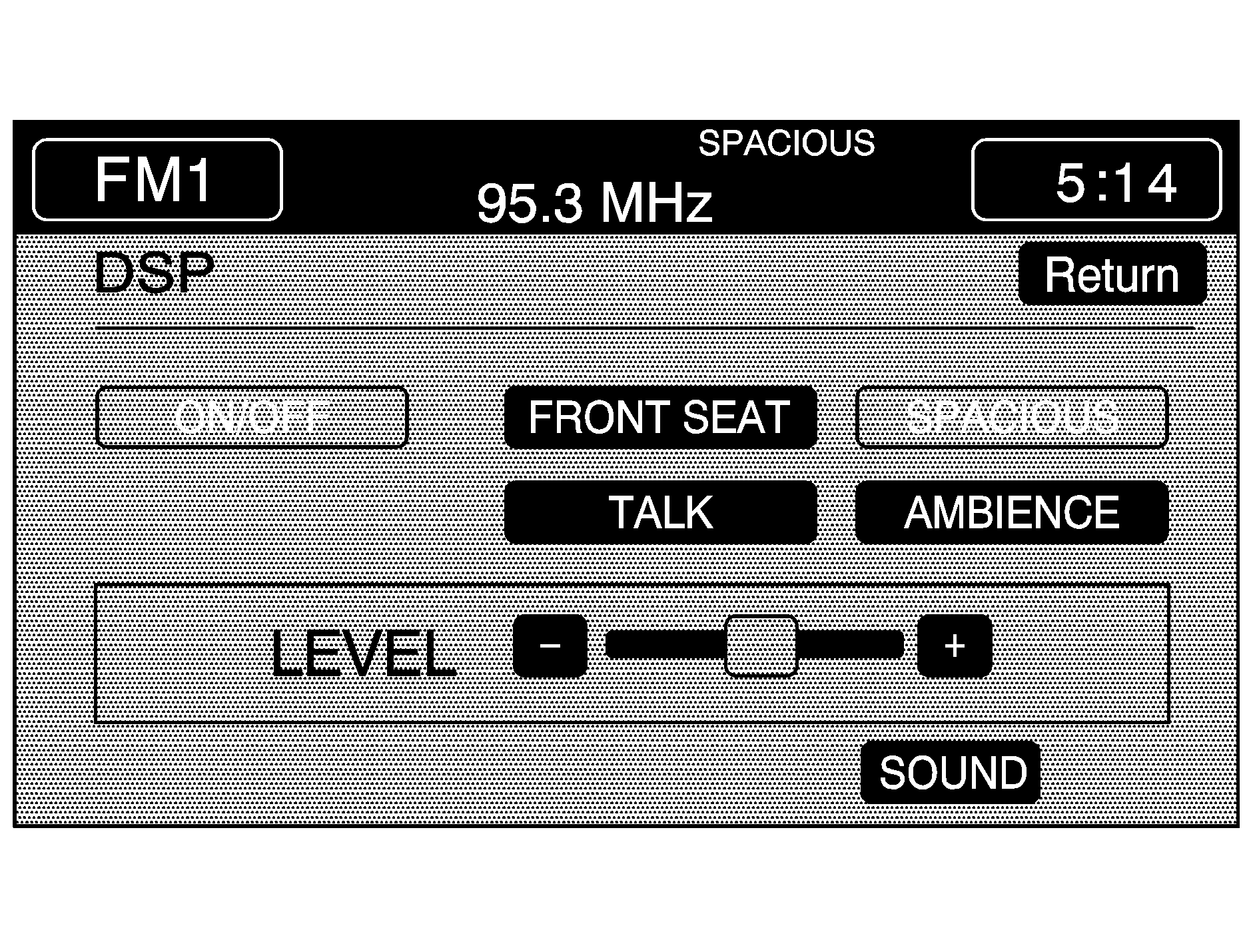
DSP (Digital Signal Processing): If you have the Bose system, you will have this feature. The DSP feature is used to provide a choice of four different listening experiences. DSP can be used while listening to the audio system or the CD player. The audio system can store separate DSP settings for each source (except weather band, which is always set to TALK) and preset stations. To save the DSP settings for your preset stations, you can use the SOUND button or touch the DSP button from the preset station menu to access the DSP menu. See "Sound Menu (Tone, DSP, Fade and Balance)" listed previously in this section for more information.
Touch the DSP button to change the following options:
ON/OFF: Press this button to turn DSP on or off.FRONT SEAT: Press this button to adjust the audio to give the front seat occupants the best possible sound qualities. FRONT SEAT can be used at any time for any material. Rear seat passengers in the vehicle may not get the same effect.
TALK: Press this button when listening to non-musical material such as news, talk shows and sports broadcasts. TALK makes spoken words sound very clear.
SPACIOUS: Press this button to make the listening space seem larger.
AMBIENCE: Press this button to enhance the stereo effect.
LEVEL: Press the minus (-) or plus (+) button to change the level of the DSP effect after selecting a DSP setting.
SOUND: Press this button to access the Sound menu. See "Sound Menu (Tone, DSP, Fade and Balance)" listed previously in this section for more information.
Radio Data Systems (RDS)
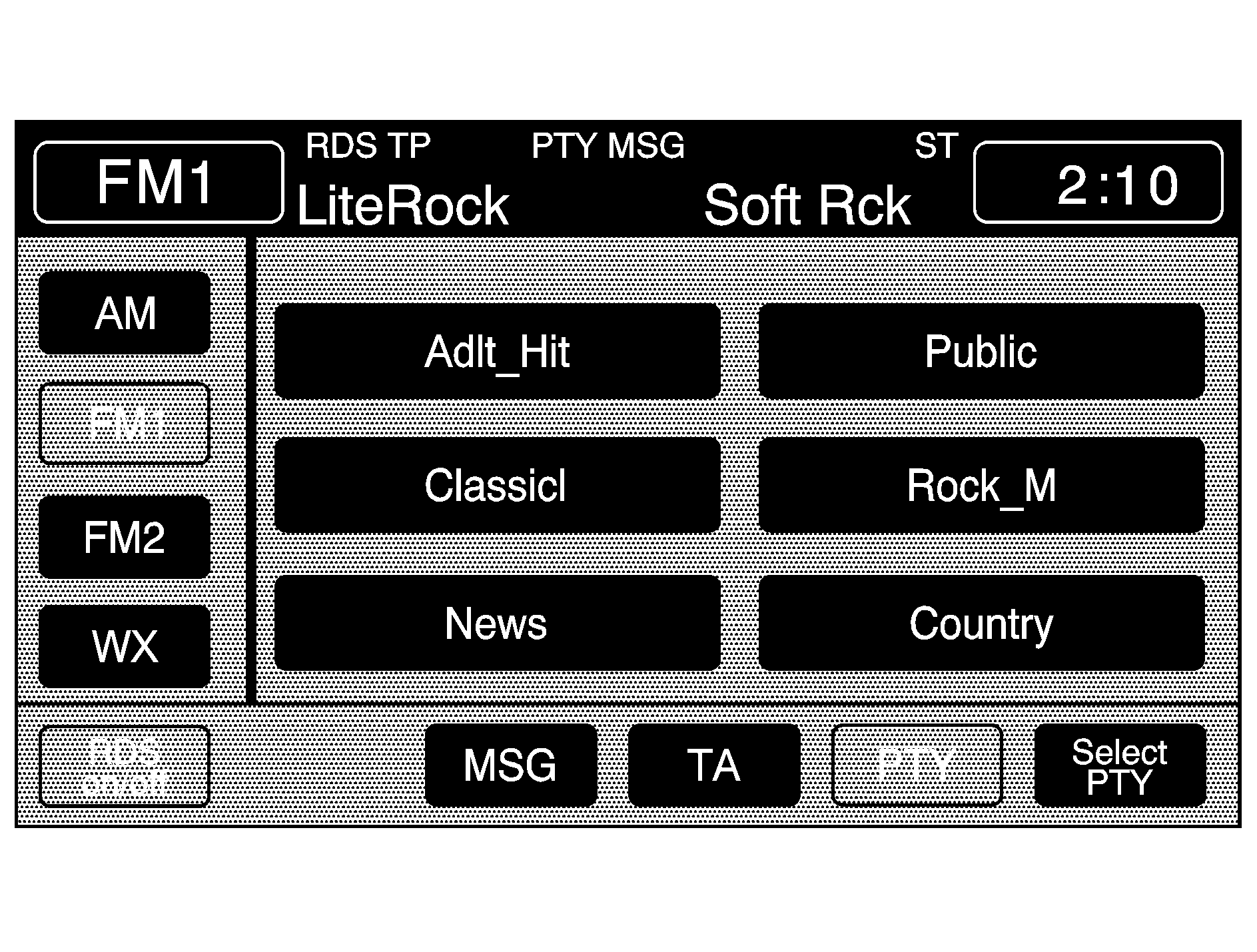
Your audio system is equipped with Radio Data Systems (RDS). RDS mode gives you many useful new features. When RDS is on, the audio system can:
| • | Seek to stations with traffic announcements, |
| • | receive announcements concerning local and national emergencies, |
| • | receive and display messages from radio stations and |
| • | search for a stronger station when a station is too weak for listening. |
RDS features are only available for use on FM stations which broadcast RDS information.
RDS: Touch this button to use the alternate RDS functions located in the preset menu for FM 1/2 only. When you touch RDS, you will only have approximately five seconds to choose RDS ON/OFF, TA, MSG, PTY or SEL PTY. If you do not make a selection, the system will return to the previous menu.If you are tuned to a station broadcasting RDS information, the station's Program Service (PS) and Program Type (PTY) will replace the station's frequency on the status line at the top of the display. After approximately five seconds, if available, the program type will be replaced on the display by the station's program type name. The program type and program type name may be the same or different.
If the audio system is tuned to a station that is not broadcasting RDS information, the station's frequency will remain on the display. While RDS is on, the audio system will search for a stronger station in the network, when a station gets too weak for listening.
The RDS feature relies upon receiving specific information from the RDS stations. These features will only work when RDS information is available.
TA: Touch this button to receive traffic announcements. The audio system will turn on the TA display. TA will appear on the display if the tuned station broadcasts traffic announcements. You may also receive traffic announcements from stations in the network related to the tuned station. If the current tuned station does not broadcast traffic announcements, the audio system will seek to a station which will. When the audio system finds a station which broadcasts traffic announcements, it will stop. If no station is found, the TA icon will turn off. While a traffic announcement plays, the audio system uses a special type of volume called TA volume. To increase TA volume, touch the VOL button on your steering wheel or use the VOL up or down buttons during the announcement. See "Voice Guidance Volume Settings" under Setup Menu for more information. When a traffic announcement comes on the current radio station or a related network station, you will hear it, even if the volume is muted or a compact disc is playing. If the audio system tunes to a related network station for a traffic announcement, it will return to the original station when the announcement is finished. If the compact disc player was being used, the compact disc will stay in the player and resume play at the point where it stopped. Touch the RDS button, followed by the TA button again to turn TA off.MSG (Message): When RDS is on, if the current station has a message, the MSG icon will appear on the display. Touch the message button from the preset screen menu to view the message. If the whole message does not appear on the display, parts of the message will appear every three seconds until the message is completed. Once the complete message has been displayed, the MSG icon will disappear from the display until another new message is received. The message button will remain available to allow you to display the entire message again.

PTY: PTY allows you to seek only stations with types of programs you want to listen to. This button is used to turn on and off Program Type (PTY) features. With RDS on touch the RDS button, followed by the PTY button. The PTY display will turn on and will appear on the display. Touch the RDS button, followed by this button again to turn the PTY display off.
Select PTY (Select Program Type): With RDS and PTY on, touch the RDS button, then the SEL PTY button. The PTY menu screen will appear. Use the scroll up and down arrows to select a PTY. Touch your PTY selection and the system will return you to the screen with the preset stations shown. See Steps 1 through 7 under "Preset Station Menu" to store the selected PTYs. The selected PTY is then stored on the preset. You can now touch the PTY preset to recall your settings. When the PTY display is on, press TUNE/SEEK and SCAN to find radio stations of the PTY selected. The last PTY selected will be used for seek and scan modes. If a station with the selected PTY is not found, NONE FOUND will appear on the display. If both PTY and TA are on, the audio system will search for stations with traffic announcements and the selected PTY.
PTY (Program Type) Presets: The six preset buttons let you return to your favorite Program Types (PTYs). These buttons have factory PTY preset stations. See "RDS Program Type (PTY) Selections" later in this section. You can set up to 12 PTYs (6 FM 1 and 6 FM2). To save a PTY preset, do the following:
- Touch the FM 1/2 source button.
- Touch the RDS button to enter the RDS menu.
- Touch the RDS ON/OFF button to turn RDS on.
- Touch the PTY button.
- Touch the SEL PTY button and select the desired PTY from the list. See "RDS Program Type (PTY) Selections" following for a listing of PTYs available.
- Touch and hold one of the six buttons for more than two seconds or until you hear a beep. Whenever you touch that numbered button for less than two seconds, the PTY you set will return.
- Repeat the steps for each preset button.
Once you have stored a PTY for each of your preset stations, you can recall a PTY preset by touching the preset station for less than two seconds. Then use TUNE/SEEK or SCAN to locate a station for that PTY selection.
When battery power is removed and later re-applied, you will not have to reset your RDS preset stations because the audio system remembers them.
ALERT: This type of announcement warns of national or local emergencies. You will not be able to turn off alert announcements. Alert announcements will come on even if RDS mode is turned off. ALERT appears on the display when an alert announcement plays. The audio system uses TA volume during these announcements. To increase volume, touch the VOL button on your steering wheel or use the VOL up and down buttons during the announcement. See "Voice Guidance Volume Settings" under Setup Menu for more information. When an alert announcement comes on the tuned radio station or a related network station, you will hear it, even if the volume is muted or a compact disc is playing. If the audio system tunes to a related network station for an alert announcement, it will return to the original station when the announcement is finished. If the compact disc player is playing, the player will stop for the announcement and resume when the announcement is finished.PTY List | Description |
|---|---|
Adlt Hit | Adult Hits |
Any | Any |
Cls Rock | Classical Rock |
Classicl | Classical |
College | College |
Country | Country |
Info | Information |
Jazz | Jazz |
Language | Language |
News | News |
Nostalga | Nostalgia |
Oldies | Oldies |
Persnlty | Personality |
Public | Public |
R & B | Rhythm and Blues |
Rock M | Rock Music |
Rel Musc | Religious Music |
Rel Talk | Religious Talk |
Soft | Soft |
Soft R & B | Soft R & B |
Soft Rck | Soft Rock |
Sports | Sports |
Talk | Talk |
Top 40 | Top 40 |
Weather | Weather |
Factory PTY Presets
Your audio system comes with these factory PTY preset stations. To change the factory settings, see Step 1 through 5 under "PTY (Program Type) Presets" listed previously.
Preset | FM 1 | FM 2 |
|---|---|---|
Preset 1 | Adult Hits | Jazz |
Preset 2 | Classical | Oldies |
Preset 3 | News | Religious Music |
Preset 4 | Public | Soft Rock |
Preset 5 | Rock M | R & B |
Preset 6 | Country | Top 40 |
XM™ Satellite Radio
XM is a continental U.S. based satellite radio service that offers up to 100 coast to coast channels including music, news, sports, talk and children's programming. XM provides digital quality audio and text information, including song title and artist name. A service fee is required in order to receive the XM service. For more information, contact XM at www.xmradio.com or call 1-800-852-XMXM (9696).
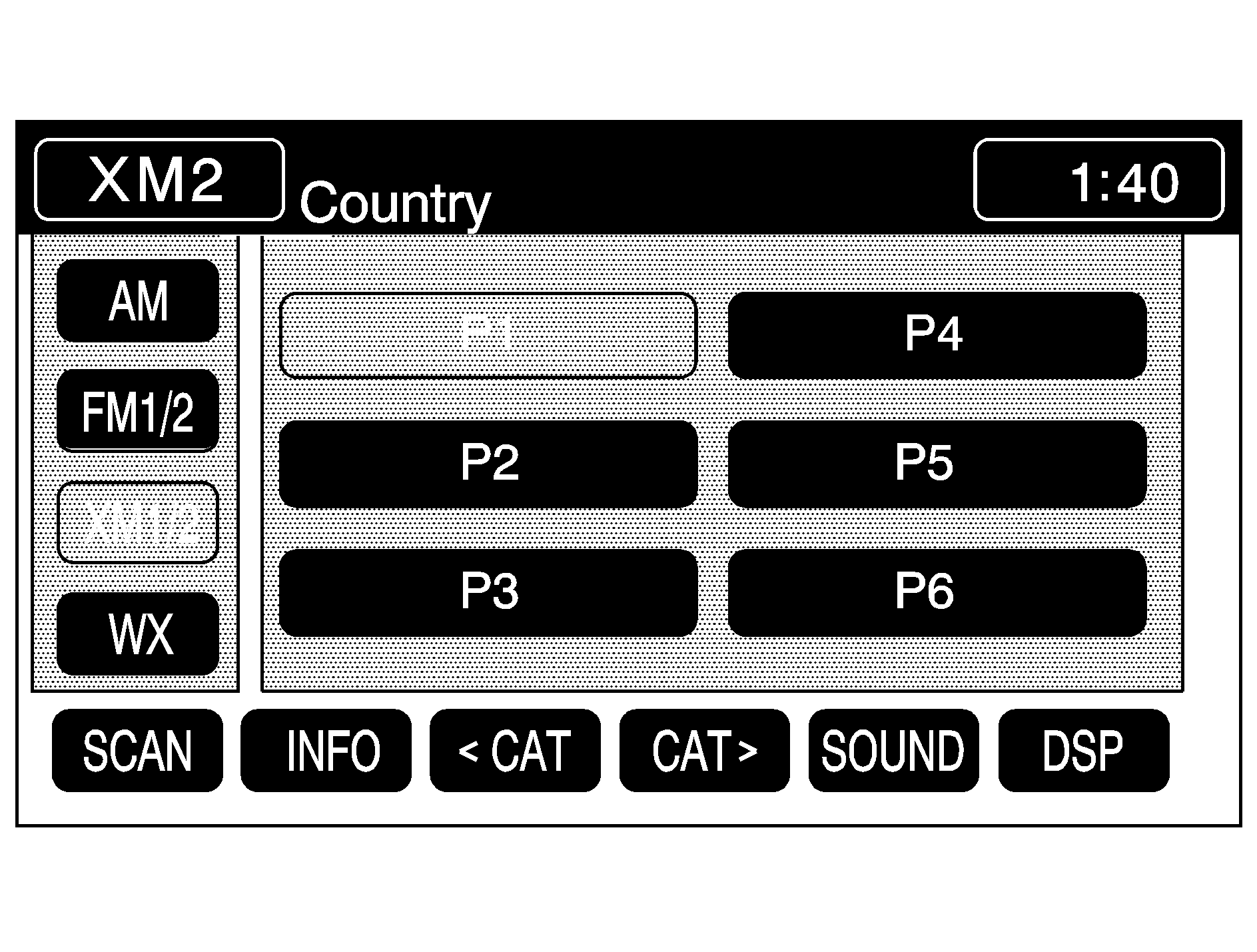
INFO (Information): Touch this button while in XM mode to retrieve various pieces of information related to the current song or channel. By touching the INFO button, you may retrieve four different categories of information: Artist Name/Feature, Song/Program Title, Channel Category, and other Additional Information that may be broadcast on that channel. Additional Information messages may only be available at certain times or on certain programs. If an Additional Information message is being broadcast on the tuned channel, INFO will appear on the display. Each of the four information types may have multiple pages of text. To reach a category, touch the INFO button repeatedly until the desired type is displayed. If there are multiple pages of text for the information selected type, the radio will automatically display all the pages for that type at a rate of approximately one page every three seconds before timing out and returning to the default display. You may override this feature by touching the INFO button to review all of the pages at your own pace.
XL (Explicit Language Channels): XL on the radio display, after the channel name, indicates content with explicit language. These channels, or any others, can be blocked at a customer's request, by calling 1-800-852-XMXM (9696).
Setting Program Type (PTY) Preset Stations
CAT (Category): Press the arrows to select a category.Once the desired category is displayed, press TUNE/SEEK to select the category and take you to the category's first station. If you want to go to another station within that category, press TUNE/SEEK once.
Touch and hold one of the desired P1-P6 presets to store the selected station as a preset. If PTY times out and is no longer on the display, start again.
SCAN: Use this button to scan through the channels within a category or scan through the preset stations. To scan through the channels in a category, do the following:- Select a category by using the category arrows.
- Once the desired category is displayed, touch SCAN and the radio will begin scanning within your chosen category.
- Touch SCAN again to stop at a particular section.
To scan through your preset stations, touch and hold the SCAN button. Touch the button again to stop scanning.
XM Radio Messages
Radio Display Message | Condition | Action Required |
|---|---|---|
XM Updating | Updating encryption code | The encryption code in your receiver is being updated, and no action is required. This process should take no longer than 30 seconds. |
No XM signal | Loss of signal | Your system is functioning correctly, but you are in a location that is blocking the XM signal. When you move into an open area, the signal should return. |
Loading XM | Acquiring channel audio (after 4 second delay) | Your radio system is acquiring and processing audio and text data. No action is needed. This message should disappear shortly. |
Channel Off Air | Channel not in service | This channel is not currently in service. Tune in to another channel. |
Channel Unavail | Channel no longer available | This previously assigned channel is no longer assigned. Tune to another station. If this station was one of your presets, you may need to choose another station for that preset button. |
No Artist Info | Artist Name/Feature not available | No artist information is available at this time on this channel. Your system is working properly. |
No Title Info | Song/Program Title not available | No song title information is available at this time on this channel. Your system is working properly. |
No CAT Info | Category Name not available | No category information is available at this time on this channel. Your system is working properly. |
Not Found | No channel available for the chosen category | There are no channels available for the category you selected. Your system is working properly. |
No Information | No Text/Informational message available | No text or informational messages are available at this time on this channel. Your system is working properly. |
XM Theftlocked | Theft lock active | The XM receiver in your vehicle may have previously been in another vehicle. For security purposes, XM receivers cannot be swapped between vehicles. If you receive this message after having your vehicle serviced, check with the servicing facility. |
XM Radio ID | Radio ID label (channel 0) | If you tune to channel 0, you will see this message alternating with your XM Radio 8 digit radio ID label. This label is needed to activate your service. |
Unknown | Radio ID not known (should only be if hardware failure) | If you receive this message when you tune to channel 0, you may have a receiver fault. Consult with your dealer. |
Check XM Receiver | Hardware failure | If this message does not clear within a short period of time, your receiver may have a fault. Consult with your retail location. |
